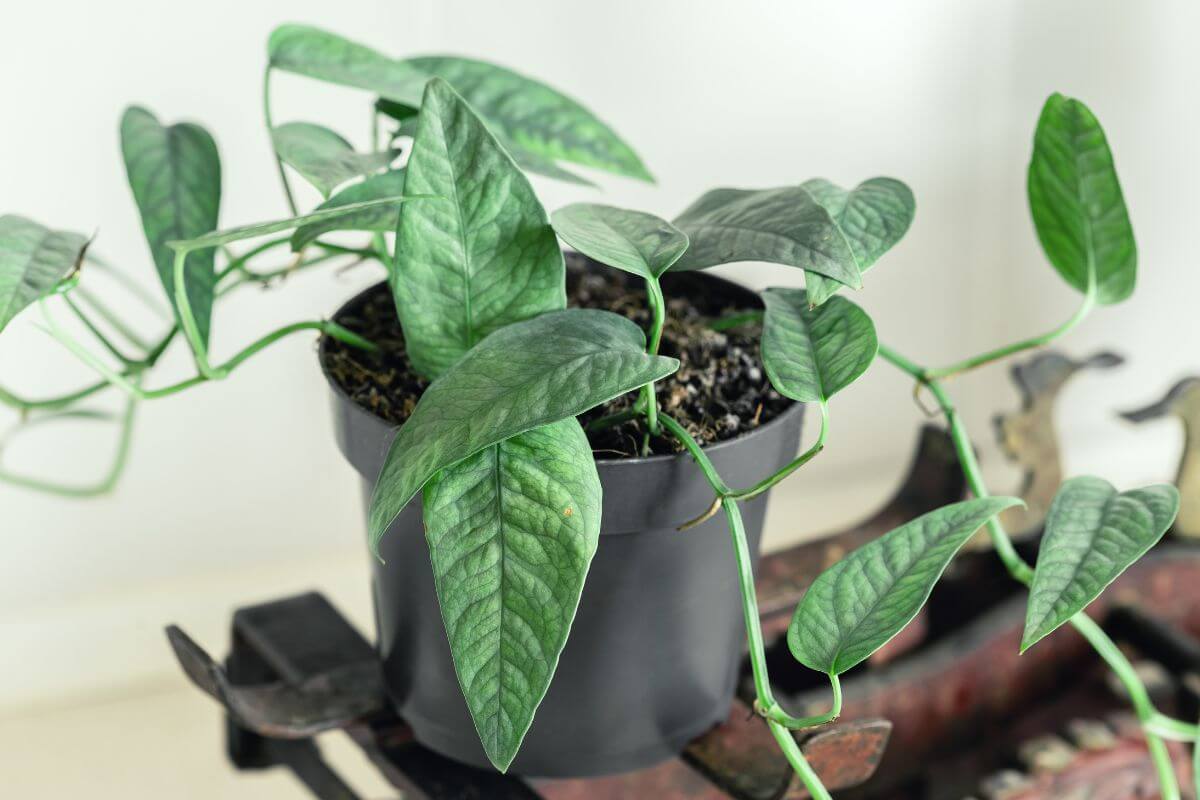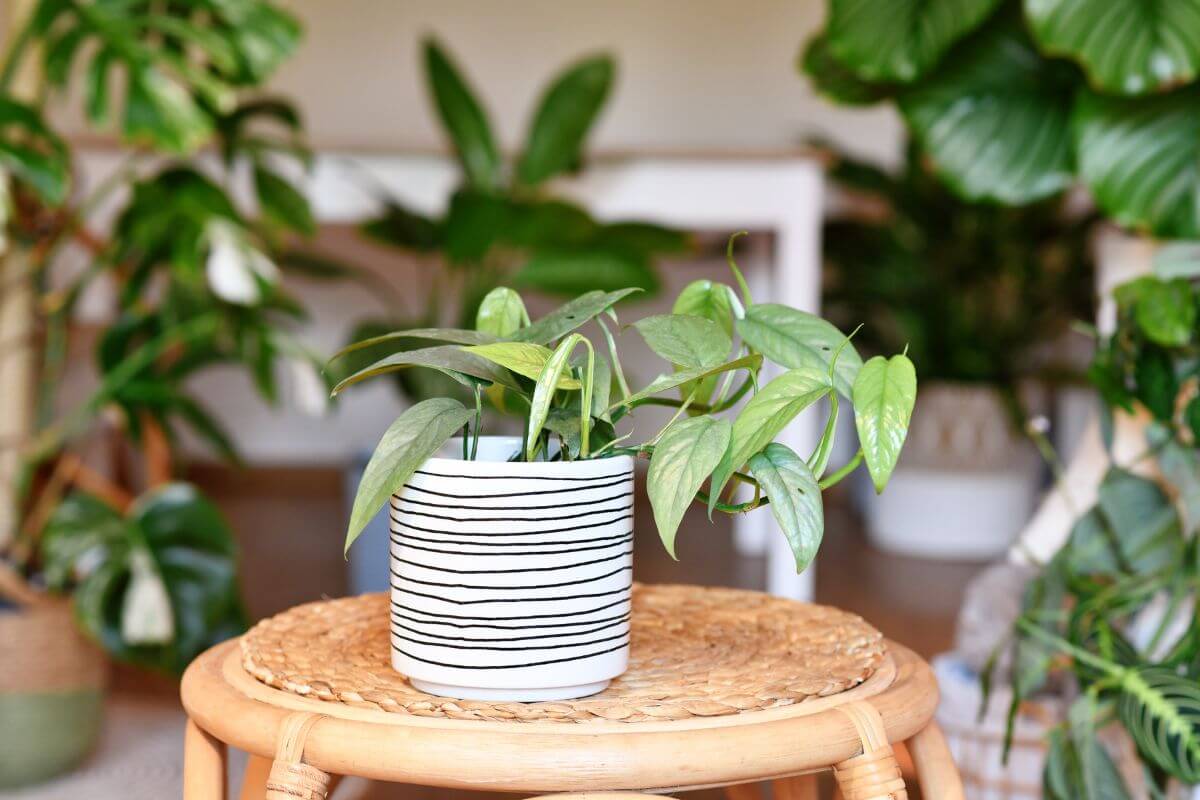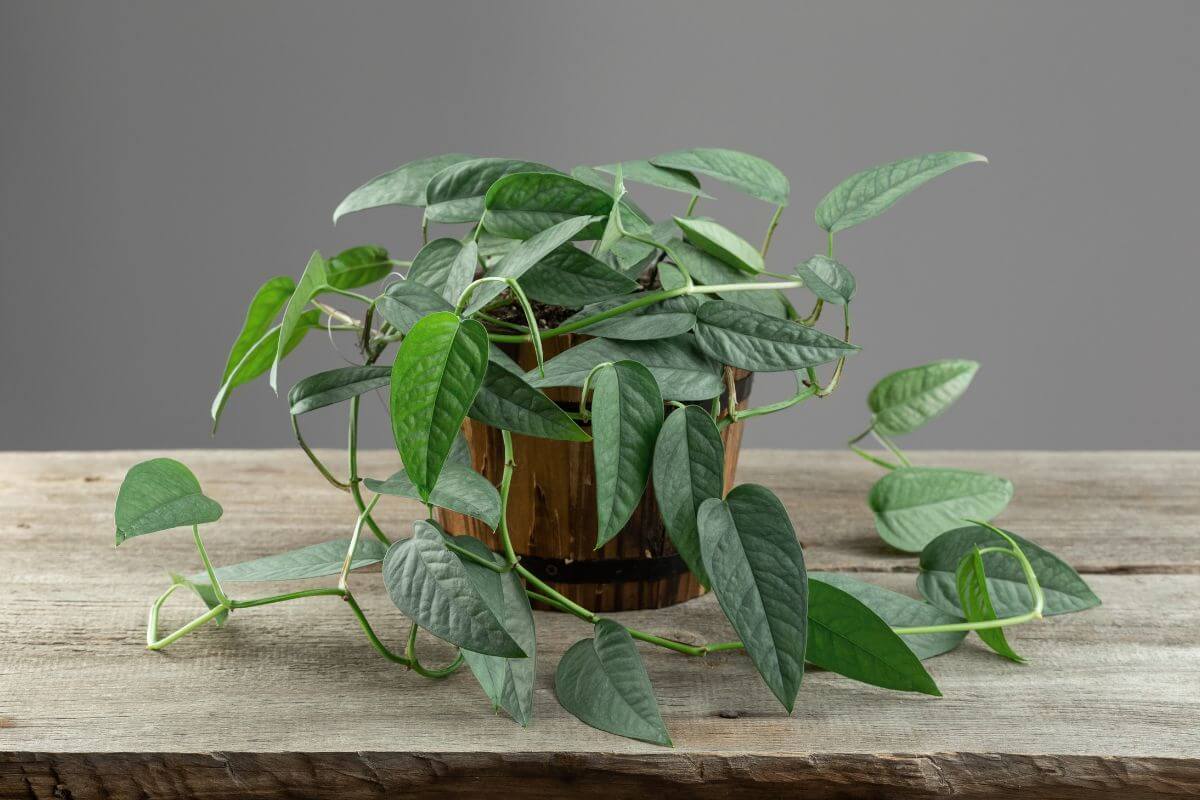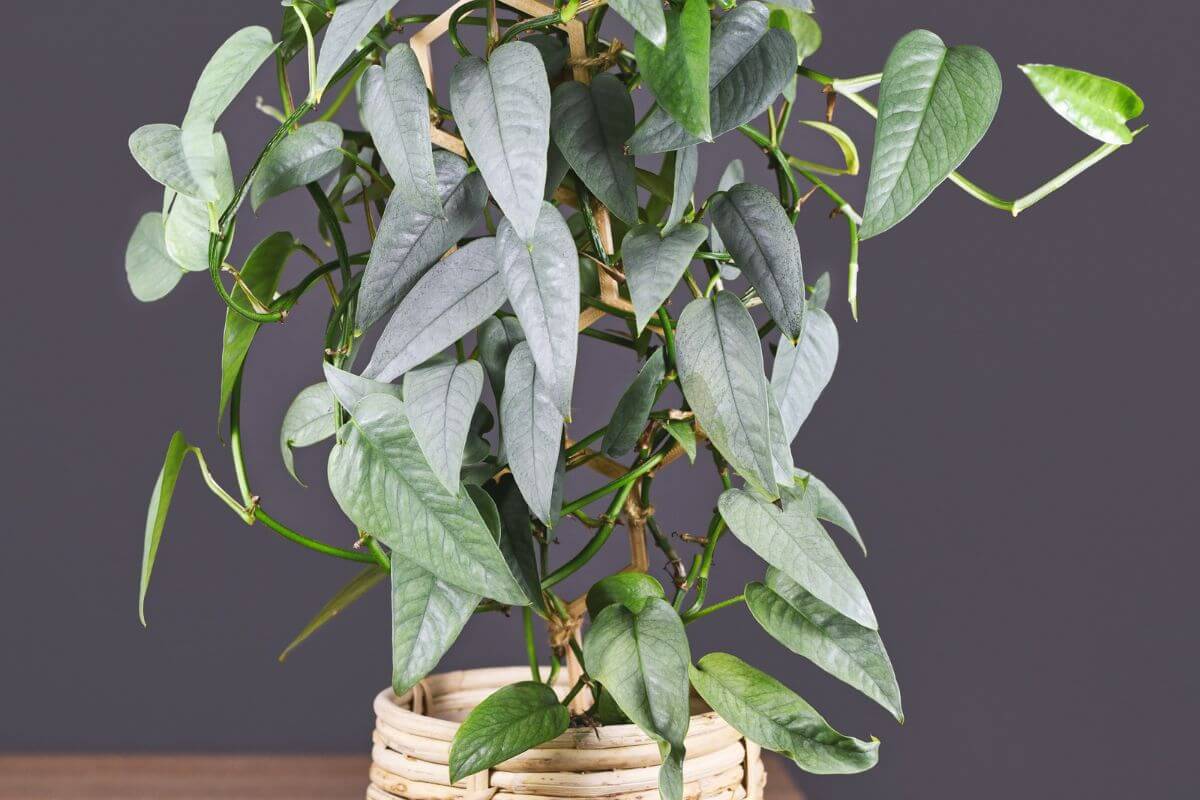Cebu Blue Pothos are an easy plant to care for and grow indoors. They require minimal water and produce beautiful foliage throughout the year.
If you want to grow your own houseplants, these are some of the easiest to start and maintain. Learn more about how to care for and grow the Cebu Blue Pothos plants.
Cebu Blue Pothos Overview

For those of you that are fans of silver-blue tinted plants, consider getting yourself a Cebu Blue Pothos, botanically known as the Epipremnum pinnatum, for your indoor garden.
This is a low maintenance plant that will give off a nice silvery-blue hue all year round. It’s also very easy to grow and can be kept in any room of the house.
An evergreen tropical vining plant from the Cebu island in the Philippines. It is low maintenance and a beautiful addition to any location. Either in hanging baskets, on high perches, or anywhere you feel appropriate, the Cebu Blue is a striking plant with elongated oval-shaped foliage.
There are a number of other names that the Cebu Blue is known by, including: Blue Pothos, Dragon-tail plant, Devil’s Ivy, Blue Philodendron, Centipede Tongavine, and Cebu Island.
Cebu Blue Pothos Plant Care Guide
Soil for the Cebu Blue Pothos

All-purpose, well-draining potting soil is best for your Cebu Blue Pothos.
To ensure proper drainage, you can add perlite to improve both soil aeration and drainage. Add one part of perlite to two parts of potting soil for an optimal growing medium.
Drainage holes in pots are also a crucial requisite for correct drainage. Even when using a plastic pot inside a vase, make sure there are sufficient holes in the bottom. Don’t let the drainage holes become blocked.
To improve aeration in the soil bed manually, use a chopstick or similar, to loosen the soil bed on occasion.
Well-draining soil will allow excess water to drain out of the pot. That will help prevent waterlogged soil and overwatering problems.
Temperature for the Cebu Blue Pothos
Similar to other Pothos cultivars, the Cebu Blue is not particularly demanding when it comes to temperatures.
Most indoor temperatures will be more than adequate. The Cebu Blue thrives in a temperature range of 60° to 80° Fahrenheit and can tolerate temperatures from 50° to 90°F.
It’s best to keep this and any other indoor plant away from air conditioning vents that
Light for the Cebu Blue Pothos

Like most Pothos varieties, the Cebu Blue can survive multiple lighting conditions, so it’s important to know what you expect from your plant. There are different light requirements based on how large a plant you want.
If you want a Cebu Blue that grows rapidly, then providing it with lots of bright indirect light will encourage growth. Both east and west-facing windows will offer this type of lighting.
This pothos variety can tolerate some direct sunlight early in the morning or later in the afternoon, but it should be limited to a few hours.
Remember that the pothos’ natural habitat is the tropical rainforest, so sunlight exposure needs to be filtered or dappled. Direct light can scorch the foliage.
Window light is best, but not necessarily directly on a windowsill.
Medium indirect light is also an option, as well as low light, but your Cebu Blue will grow more slowly.
Water for the Cebu Blue Pothos
How much you need to water, will depend on several factors, such as the pot, climate, temperature, season of the year, light, and humidity.
When the soil bed is almost dried out, it’s time to water. You can check how dry the soil is by placing your finger 1-2 inches into the soil.
If you feel better with more certainty, a moisture meter is ideal for checking moisture levels. Place it into the soil bed at different points and various depths, and it will indicate how damp your soil is. If “dry” shows up pretty much wherever you place it, give your pothos a drink.
Underwatering and overwatering are two of the biggest issues, so keep an eye on how often you need to water the plant in your area.
A Cebu Blue will begin to drop foliage if underwatered and left too long without water. When overwatered, it can lead to soggy soil and root rot.
Humidity for the Cebu Blue Pothos
As a native of tropical rain forests, higher humidity levels is preferred, but not mandatory for its survival.
Any level between 40 and 60% humidity will be optimal and can be achieved with a humidifier, pebble tray, or grouping plants together.
Fertilizer for the Cebu Blue Pothos
The Cebu Blue pothos variety is not a big feeder, so it will not need a lot of fertilizer. You can choose to avoid feeding it, but an occasional fertilizer will encourage faster and much fuller growth.
Dilute a basic houseplant fertilizer to half strength and feed it bi-weekly in the growing season.
During winter dormancy, do not fertilize as it’s not growing. When growing season starts up again, resume fertilizing.
Repotting the Cebu Blue Pothos

When Cebu Blue’s roots takes up all the space in its actual pot, it’s time to report it with a larger pot and fresh soil.
Select a new pot that is one size larger or at the most two inches bigger and fill it with fresh growing medium. This will most likely occur once a year to a year and a half.
New pots should never be much larger than your plant’s root ball. When pots are too large, the soil can retain too much water and contribute to the development of root rot.
When you repot plants, make sure that the planting depth is the same as in the previous container. Be sure to give it lots of bright light for healthy growth.
Repotting is ideal in the spring, especially if you live in a colder climate, as plants will enter dormancy for the winter and should be left undisturbed.
If you live in a climate that is warm year-round, you can repot at any time.
Pruning the Cebu Blue Pothos
Trimming your Pothos occasionally will stimulate new growth. Cutting the tropical vines regularly will allow for fuller, bushier growth.
Propagating the Cebu Blue Pothos
The Cebu Blue can be propagated either in water or in soil. Take a stem cutting from your Pothos by cutting about one inch from a leaf node, either above or below. Make sure there is a node, otherwise your stem cutting will not develop roots.
To propagate the Cebu Blue pothos plant in water:
- From the mother plant, take a stem cutting with approximately three nodes and remove the bottom leaves
- Place the cut leafless end in a jar with water and wait for approximately a month until the roots develop.
- When the roots reach an inch in size, the Cebu Blue can be transplanted into potting mix.
- For at least the first month, keep the soil moist until the pothos adjusts to the move from water to soil.
To propagate in soil, take a stem cutting with a single node and leaf. Place the cut end, including the leaf node into the soil bed and wait for root development and new growth.
Propagating cuttings in soil will usually take longer than water.
Cebu Blue Pothos Toxicity and Pets
The Cebu Blue Pothos is toxic to pets like cats and dogs. It contains insoluble calcium oxalate, which can cause swelling, drooling, vomiting, and more if ingested.
It’s best to keep the Cebu Blue away from pets and small children. If any symptoms do appear with your pets, call your veterinarian immediately.
Cebu Blue Pothos Problems and Pests

Root rot is one of the primary risks for pothos cultivars. Root rot can occur when the plant has insufficient light, receives too much water, or the soil bed is so compact that no air reaches the roots.
Brown leaves can mean excessive sunlight or too much fertilizer.
Yellow leaves can also indicate a need for water or light. Watering on a regular schedule can help prevent this.
As for pet infestations, the Cebu Blue is susceptible to spider mites and mealybugs. They need to be removed and then treat your plant with neem oil or insecticidal soap.
Cebu Blue Pothos Care Final Thoughts
All in all, the Cebu Blue Pothos is a great addition to any home garden. It doesn’t require much maintenance, but does need plenty of sun and good drainage.
The Cebu Blue Pothos is very easy to grow and care for, making it a great choice for beginners.
For more care guides on pothos varieties, check out these articles:
- Overview Guide of Pothos Varieties
- Neon Pothos Care Guide
- Silver Satin Pothos Care Guide
- Jessenia Pothos Care Guide
Cebu Blue Pothos FAQs
Is Cebu Blue pothos rare?
The Cebu Blue pothos is one of the more rare pothos varieties out there. Its silvery-blue leaves make it a popular variety. It’s a beautiful and easy-care plant , making it a perfect houseplant for anyone looking for something unique.
What is so special about Cebu Blue pothos?
The Cebu Blue pothos is special for its slivery-blue leaves that sparkle in the right light conditions. As a climbing and trailing plant, it can make for a beautiful addition to the home. This makes the Cebu Blue pothos a great option for indoor plants.
Do Cebu Blue pothos grow fast?
The speed at which blue pothos grows depends on many factors, such as soil conditions, temperature, sunlight, water levels, and fertilizer application. If you want to grow healthy plants, apply fertilizer once every couple of weeks. They can grow a few feet each growing season.
Is Cebu Blue toxic?
Yes, the Cebu Blue pothos is toxic to small animals because it has insoluble calcium oxalate. Keep your cats and dogs away from it. It’s also best not to allow young children to play with the plant.
How long does a Cebu Blue pothos live?
The Cebu Blue pothos can usually live for 15-20 years. The lifespan of the plant is determined by how well it was cared for. One key care tip is to keep the soil moist, but also allow the plant’s roots to dry out between waterings. This prevents disease, promotes healthy growth and provides nutrients.
Is Cebu Blue a philodendron or pothos?
The Cebu Blue is a pothos. A pothos is a climber or vine that has thin stems and smaller leaves. Philodendrons are similar to pothos, but they usually have thicker stems and larger leaves.
How long for Cebu Pothos to fully mature?
Cebu Blue Pothos plants can take up to 20 years to fully mature. How long it takes depend on the level of care given to the plants. Proper care will ensure that the plant grows healthily and reaches maturity sooner. Adding plant fertilizer will also help increase its growth rate.



